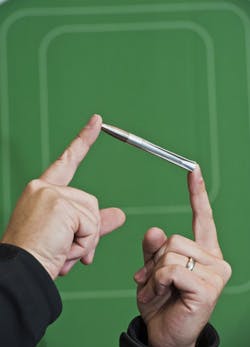Sandia’s laser-guided bullet prototype can hit small targets a mile away
Albuquerque, NM--Sandia National Laboratories researchers Red Jones, Brian Kast, and their colleagues have invented a finned self-guided bullet for small-caliber, smooth-bore firearms that could accurately hit laser-designated targets at distances of more than a mile.
The design for the four-inch-long bullet includes an optical sensor in the nose to detect a laser-beam spot on a target. The sensor sends information to guidance and control electronics that use an algorithm in an 8-bit CPU to command electromagnetic actuators. These actuators steer small fins that guide the bullet to the target with a flight-path-correction rate of 30 times a second.
No rifling
Most bullets are shot from rifles that have grooves, or rifling, that cause them to spin so they fly straight, like a long football pass. To enable a bullet to turn in flight toward a target and to simplify the design, the spin had to go, said Jones. The bullet flies straight due to its aerodynamically stable design, which consists of a center of gravity that sits forward in the projectile and tiny fins that enable it to fly without spin, just as a dart does, he said.
A nighttime field test in which a small LED was attached to the bullet showed the battery and electronics can survive flight, Jones said. Researchers also filmed high-speed video of the bullet radically pitching as it exited the barrel. The bullet pitches less as it flies down range, a phenomenon known to long-range firearms experts as “going to sleep.” Because the bullet’s motions settle the longer it is in flight, accuracy improves at longer ranges, Jones noted.
45X accuracy improvement at 1000 m
Computer aerodynamic modeling shows the design would result in dramatic improvements in accuracy, according to Jones. Simulations showed an unguided bullet under real-world conditions could miss a target more than a half mile away (1,000 m away) by 9.8 yards (9 m), but a guided bullet would get within 8 in. (0.2 m), according to the patent.
Plastic "sabots" provide a gas seal in the cartridge and protect the delicate fins until the sabots drop off after the bullet emerges from the firearm’s barrel. The bullet can reach speeds of 2,400 feet per second, or Mach 2.1, using commercially available gunpowder. The researchers are confident it could reach standard military speeds using customized gunpowder.
“We have a very promising technology to guide small projectiles that could be fully developed inexpensively and rapidly,” Jones said. Sandia is seeking a private company partner to complete testing of the prototype and bring a guided bullet to the marketplace.
Source: https://share.sandia.gov/news/resources/news_releases/bullet/
About the Author
John Wallace
Senior Technical Editor (1998-2022)
John Wallace was with Laser Focus World for nearly 25 years, retiring in late June 2022. He obtained a bachelor's degree in mechanical engineering and physics at Rutgers University and a master's in optical engineering at the University of Rochester. Before becoming an editor, John worked as an engineer at RCA, Exxon, Eastman Kodak, and GCA Corporation.


